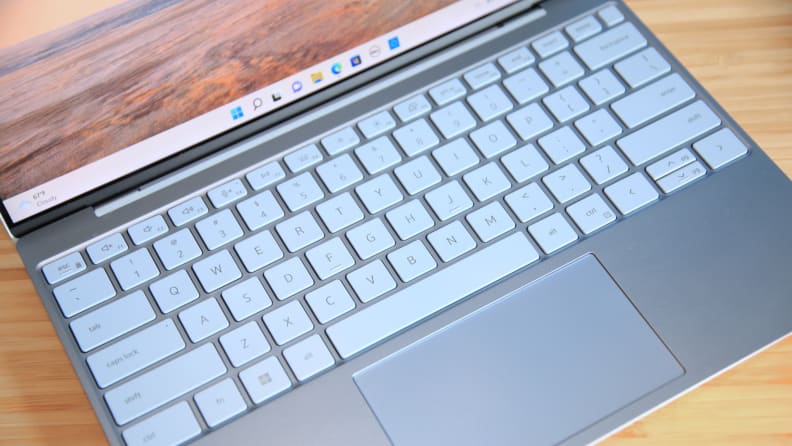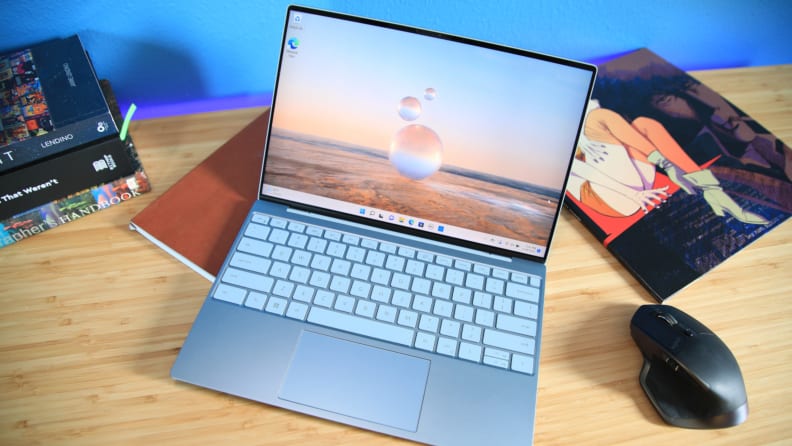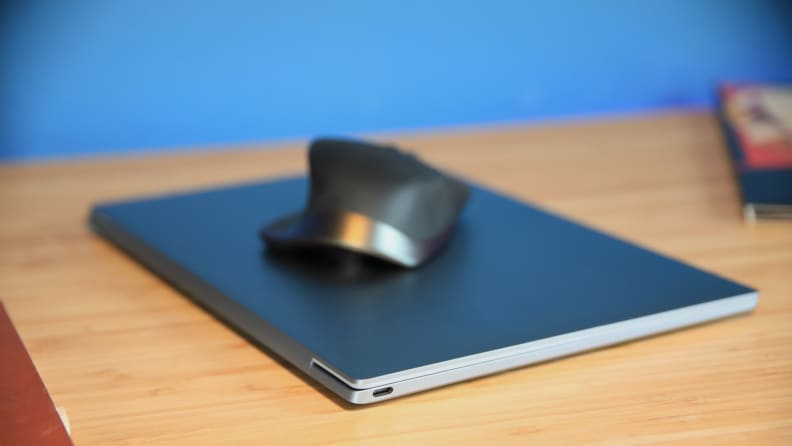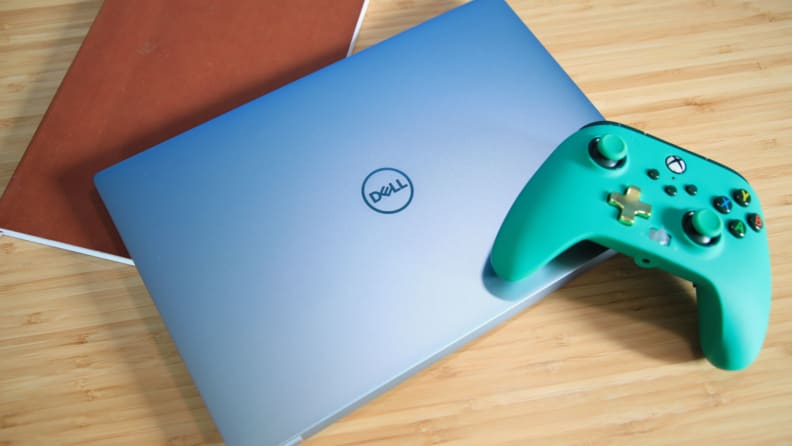Pros
-
Sturdy and functional design
-
Great battery life
-
Competitive pricing
Cons
-
Mediocre performance
-
Only two Thunderbolt ports
-
Webcam and microphone don’t impress
About the Dell XPS 13 9315
Here are the specs of the laptop we tested:
- Processor: Intel Core i5-1230U
- Graphics: Intel Iris Xe
- RAM: 16GB LPDDR5
- Storage: 512GB PCIe NVMe SSD
- Display: 13.4-inch 1920 x 1200 IPS LCD
- Wireless connectivity: Wi-Fi 6E, Bluetooth 5.2
- Wired connectivity: 2x Thunderbolt 4 with USB-4, DisplayPort Alternate Mode, and Power Delivery
- Webcam: 720p front-facing
- Battery: 51 watt-hours
- Weight: 2.59 pounds
- Size: 11.63 x 7.68 x 0.55 inches
The new entry-level Dell XPS 13 gets a price cut to just $830, a big cut from the prior model’s $950. Despite this, the base configuration is well equipped with 8GB of RAM and 512GB of solid state storage.
My review configuration, with 16GB of RAM and a touchscreen upgrade, is currently $1,150. Pricing tops out at $1,599 with a 12th-gen Core i7, Windows 11 Pro, 32GB of LPDDR5 RAM, and a 1TB SSD.
What we like
It nails the fundamentals

The spacious keyboard provides a good tactile experience.
Laptop manufacturers often go to great lengths to obscure a simple reality: the laptop is, at its core, a solved problem. It’s no secret users want a good keyboard, a large touchpad, low weight, and a sturdy feel. Yet there are only so many ways to spin these traits into attractive, exciting new models.
The latest Dell XPS 13, unlike the XPS 13 Plus, doesn’t overreach in an effort to reinvent the wheel. It’s a simple laptop that delivers the traits every great laptop should get right. The keyboard has an excellent key feel and a spacious layout, the responsive touchpad (which measures 4.5 inches by 2.5 inches) is as large as the chassis allows, and the sturdy chassis weighs just 2.59 pounds.
Dell’s XPS 13 also avoids flaws found in the more expensive XPS 13 Plus, as well as some competitors like the Microsoft Surface Laptop 4 and Razer Book; it isn’t too loud, too hot, overly thick, or lacking in storage capacity and performance.
I have one complaint: it’s boring. The XPS 13 ditches the soft-touch interior found on prior models, and the XPS 13 Plus, in favor of a basic, silver aluminum finish both inside and out. It lacks the approachable yet unique flair of most XPS laptops. I also don’t like the silver keycaps which, inevitably, fail to precisely match the surrounding metal and cheapen the look of the laptop.
But these are nitpicks. Overall, this version of the Dell XPS 13 is a treat to use daily and, in fact, much more enjoyable than the more expensive Dell XPS 13 Plus.
I also prefer it over the Lenovo Slim 7i Carbon, Razer Book, and Apple MacBook Pro 13, all of which are excellent in their own ways. Only the new Apple MacBook Air M2 is more enjoyable; it wins because of Apple’s awesome touchpad.
The display is simple but attractive

Images and fonts are sharp and clear on this bright display with great pixel density.
The Dell XPS 13’s display doesn’t stand out at a glance; the configuration I reviewed had a 1920 x 1200 IPS touchscreen with a glossy display (a matte non-touch display is also available). Maximum brightness is listed at 500 nits and reached 506 nits in my tests.
1200p resolution can feel lackluster in today’s world of 2K, 3K, and 4K displays, but don’t let that fool you. It looks great. The pixel density of 168 pixels per inch is equal to a 27-inch 4K monitor. Tiny fonts are easy to read and the video looks sharp.
It’s also a bright, vivid display that holds up well in day-to-day use. The glare was visible on my review configuration glossy display, but the backlight was able to compensate in most situations. Colorful content like Cyberpunk: Edgerunners looks great thanks to the display’s bright, crisp presentation.
The display does fall short in dark content, as it’s lacking in contrast and suffers elevated black levels. However, the display’s maximum contrast ratio of 1740:1 is superior to the majority of laptops with an LCD display. An OLED panel, like that available on the Dell XPS 13 Plus, remains a better choice if you frequently watch movies or streaming TV on your laptop.
Still, the Dell XPS 13’s display is enjoyable for day-to-day use. Its modest pixel count and mundane IPS panel also contribute to another advantage: battery life.
The battery can last 16 hours on a charge
Intel’s 12th-gen processors have demonstrated excellent performance, but the Core i7 and Core i9 mobile processors have proven watt-hungry. This is bad news for battery life, which often falls short of expectations, but not an issue for this XPS 13 with a Core i5.
The Dell XPS 13’s Intel Core i5-1230U processor is more modest with just two Performance cores and eight Efficient cores (for a total of ten cores). The processor has a base power of only nine watts and maximum turbo power of 29 watts. By comparison, the Intel Core i7-1280P lists a base power of 28 watts and maximum turbo power of 69 watts. That’s a big difference and has a big impact on battery life.
The Dell XPS 13 endured 16 hours and 13 minutes in our web browsing battery test. That’s more than double the battery life of the Dell XPS 13 Plus. It’s a surprising result at first glance but lines up nicely with Intel's official power consumption guidance.
The Dell XPS 13 easily outperforms the Asus Zenbook S 13 OLED, which lasted six hours and 50 minutes, and comes surprisingly close to the Apple MacBook Air M2’s result of 17 hours and 10 minutes.
It helps that the Dell XPS 13 avoids anything that might hurt battery life. The 1200p display’s power consumption is not listed, but likely consumes less than the high-resolution panels available on the Dell XPS 13 Plus. The standard XPS 13 also packs a 51 watt-hour battery, which is respectable given the hardware offered here.
The price is right
Dell’s XPS line is synonymous with expensive, often to its detriment, but the new XPS 13 is an exception. It starts at just $830 for a competent configuration including an Intel Core i5-1230U processor, 8GB of memory, a 512GB solid state drive, and a non-touch display. The configuration I tested, upgraded to 16GB of memory and a touchscreen, is currently $1,150 (both prices are direct from Dell.com).
It’s not a budget machine, but inexpensive enough to be a mid-range choice. This model of XPS 13 is less expensive than either the new or old MacBook Air. It also undercuts the Asus Zenbook S 13 OLED and Lenovo Slim 7i Carbon. To be fair, those competitors have advantages such as a quicker processor and better-integrated graphics performance, but the XPS 13’s price advantage is significant.
Buyer beware: the new XPS 13 is often less expensive than the remaining stock of older XPS 13 models available from online retailers. There’s no great reason to buy the older model, so steer clear unless they’re heavily discounted.
What we don’t like
Performance is just ok

While capable, the laptop trails many other mid-range to premium laptops in performance.
The power-sipping Intel Core i5-1230U is great for battery life, but a run through our benchmarks shows portability comes at the cost of performance.
Geekbench 5 turned in a single-threaded score of 1240 and a multi-thread score of 4636 in the XPS 13’s Normal performance profile. This places the XPS 13 behind a broad swath of mid-range to premium laptops including the Dell XPS 13 Plus, which hit a single-threaded score of 1508 and a multi-thread score of 8212. Apple’s MacBook Pro 13 with an M2 processor also defeated the XPS 13, scoring 1895 and 8983.
It's a similar story in Cinebench R23, where the Dell XPS 13 scored a meager 4083. The Lenovo Yoga 6 scored 5682 in this same benchmark, while the Dell XPS 13 Plus scored 7015. I saw the same trend in browser benchmarks, like Basemark and Speedometer, and in Blender. The XPS 13 always falls behind.
The XPS 13 has trouble with graphics, too, due to its less performant version of Intel Iris Xe graphics which includes only 80 execution units and a maximum frequency of 850MHz. It scored only 4470 in 3DMark’s Night Raid test at 1080p resolution. The Lenovo Yoga 6 scored 12655, and the Dell XPS 13 Plus scored 14069.
Performance is improved in the XPS 13’s Ultra Performance mode. This raised the Geekbench 5 single-threaded score to 1499 and the multithreaded score to 7016. It also raised the Cinebench R23 to 5629. These scores remain mediocre, however, and come at the cost of added heat and fan noise. The XPS 13 isn’t a loud laptop in its standard profile but borders on annoying in Ultra Performance (though it’s still not bad for a modern laptop).
Does this mean Dell XPS 13 is slow? Not exactly. The laptop is capable in day-to-day use and modestly demanding workloads. I used the laptop to edit photos from my DSLR camera and load a 10-minute 1080p video project in Wondershare Filmora. It did the job in both scenarios.
Still, you’ll find better performance elsewhere.
It only has two ports

The Dell XPS 13 9315 has solid specs at a reduced price from its predecessor.
The Dell XPS 13 has two Thunderbolt 4 ports with support for USB-4. These ports handle DisplayPort Alternate Mode, so both can be used to output video (either over Thunderbolt/USB-C or with an adapter). Both can charge the laptop, as well.
Two ports aren’t a lot, and Dell’s decision to go all-in on modern connectivity (at the expense of USB-A) is sure to turn off some shoppers. A Thunderbolt 4 or USB-C hub, or a USB-C compatible monitor with a hub built in, is practically mandatory. The headphone jack is also absent, so you’ll need an adapter or wireless headphones.
On the plus side, Dell throws in modern wireless connectivity including Wi-Fi 6E and Bluetooth 5.2. Wi-Fi 6E can reach speeds above Gigabit Ethernet in a best-case scenario, though you’ll need a Wi-Fi 6E router to make this possible. Wireless connectivity was still strong when connected to my Wi-Fi 6 router, however.
The webcam is lackluster
The Dell XPS 13 has a basic 720p webcam. It includes an IR camera to support Windows Hello facial recognition login. (There’s a fingerprint reader, too.) Image quality, however, is not good. The image is grainy, lacks color saturation, and has difficulty deciding the appropriate exposure to use in mixed lighting.
Microphone quality is so-so. It’s passable but lacks the clarity and volume that you’re going to find in a laptop like the MacBook Pro 14 or Microsoft Surface Laptop Studio. The presentation is hollow and listeners may have trouble understanding you if you’re not facing the laptop.
Should you buy the Dell XPS 13 9315?
Yes, it’s a great portable laptop

The laptop remains a stalwart, especially at its price point.
I wasn’t sure what to expect from the Dell XPS 13. For 2022, Dell split the XPS 13 into two distinctly different models: the more affordable XPS 13 and the expensive XPS 13 Plus. I feared the base XPS 13 would become a shadow of its former self, but the opposite is true.
The base XPS 13 better represents the original mission of the laptop; it’s a premium ultraportable with excellent battery life, a durable design, and a great user experience. Performance is modest but remains fine for day-to-day use and light creative workloads. The result is a laptop that’s great for travel yet enjoyable to use for hours on end.
There are a few flaws to note. The lack of physical connectivity, including an absent headphone jack, will turn off those who prefer wired peripherals. The laptop’s webcam, microphone, and display are underwhelming; some competitors in this space offer a 1080p webcam, OLED display, or both.
These problems are excused by Dell’s modest pricing, however. It undercuts most premium Windows alternatives, and often by a couple hundred dollars. The XPS 13 delivers a premium Windows laptop experience at a mid-range price point.
Meet the tester
Matthew S. Smith is a veteran tech journalist and general-purpose PC hardware nerd. Formerly the Lead Editor of Reviews at Digital Trends, he has over a decade of experience covering PC hardware. Matt often flies the virtual skies in Microsoft Flight Simulator and is on a quest to grow the perfect heirloom tomato.
Checking our work.
Our team is here to help you buy the best stuff and love what you own. Our writers, editors, and experts obsess over the products we cover to make sure you're confident and satisfied. Have a different opinion about something we recommend? Email us and we'll compare notes.
Shoot us an email




